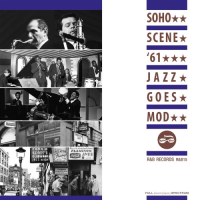
Many Americans born in the 1950s like to think of London in 1961 as a set from My Fair Lady. Lots of rosy- cheeked Julie Andrews types, coal fireplaces, and men rushing about in forest-green tweed. Also in these same imaginations, teenage guys look like the brooding Beatles during their Hamburg, Germany, period while teenage girls are bubbly and confident, and look like Helen Shapiro or Shirley Bassey.
In truth, there was a thriving jazz scene at the clubs and coffee bars in the city's Soho section. Which brings us to another myth: that much of the jazz in London in the early 1960s was traditional Dixieland. There certainly was plenty of “trad" to go around, but a majority of jazz artists were modernists influenced by the New York hard bop scene. Great London jazz musicians included Joe Harriott, Dick Morrissey, Harold McNair, Wilton Gaynair, Don Rendell, Shake Keane, Harry South, Tubby Hayes, Ronnie Scott, Alex Welsh among others.
Most of these British jazz musicians aren't household names here today because most didn't tour in the States nor were their recordings released widely in the U.S. But they were every bit as innovative and skilled as their American idols, as evidenced on R&B Records latest set available in the U.S.: Soho Scene '61: Jazz Goes Mod.
Last time I wrote about the Jazz Goes Mod series from the U.K.'s R&B Records was back in October 2016, when the label released Soho Scene '62 . Like the last set, the new one is packed with accomplished British jazz artists and groups. The set also comes with a 24-page booklet of notes by Paul “Smiler" Anderson, and it's packed with glossy color and black-and-whtie photos.
Once again, the first CD in the set features British jazz artists while the second CD features influential jazz and soul-jazz recordings by American artists. This group includes the Montgomery Brothers, Grant Green, King Curtis, Sal Nistico, Freddie Hubbard, Red Holt and others. The juxtaposition is fascinating, since the second CD provides audio references for the up-tempo, harmony-rich jazz you hear on the first. Some of the tracks on the American-artist CD may even be new to you, including Harold Corbin's Soul Sister, Red Holt's Little Liza Jane, Chirs Connor's Opportunity and Jimmy Drew's Baby Lou.
Among the high points on the British-artist CD are the Harold McNair Quartet's Harry Flicks, the Bill McGuffie Quartet's Out of Cigarettes, the Tubby Hayes Quartet's R.T.H., the Joe Harriott Quintet's Tonal, the Harry South Big Band's Southern Horizons, the Shake Keane Quintet's Fidel, the Dick Morrissey Quartet's St. Thomas and the Ronnie Scott/Jimmy Deuchar Quintet's Haunted Jazzclub.
There's no harm in imagining Cockney flower girls, London Music Hall comics and Ian Fleming shopping at Floris in London of 1961. Just understand that before Swinging London, London was already swinging with a modern jazz groove.
In truth, there was a thriving jazz scene at the clubs and coffee bars in the city's Soho section. Which brings us to another myth: that much of the jazz in London in the early 1960s was traditional Dixieland. There certainly was plenty of “trad" to go around, but a majority of jazz artists were modernists influenced by the New York hard bop scene. Great London jazz musicians included Joe Harriott, Dick Morrissey, Harold McNair, Wilton Gaynair, Don Rendell, Shake Keane, Harry South, Tubby Hayes, Ronnie Scott, Alex Welsh among others.
Most of these British jazz musicians aren't household names here today because most didn't tour in the States nor were their recordings released widely in the U.S. But they were every bit as innovative and skilled as their American idols, as evidenced on R&B Records latest set available in the U.S.: Soho Scene '61: Jazz Goes Mod.
Last time I wrote about the Jazz Goes Mod series from the U.K.'s R&B Records was back in October 2016, when the label released Soho Scene '62 . Like the last set, the new one is packed with accomplished British jazz artists and groups. The set also comes with a 24-page booklet of notes by Paul “Smiler" Anderson, and it's packed with glossy color and black-and-whtie photos.
Once again, the first CD in the set features British jazz artists while the second CD features influential jazz and soul-jazz recordings by American artists. This group includes the Montgomery Brothers, Grant Green, King Curtis, Sal Nistico, Freddie Hubbard, Red Holt and others. The juxtaposition is fascinating, since the second CD provides audio references for the up-tempo, harmony-rich jazz you hear on the first. Some of the tracks on the American-artist CD may even be new to you, including Harold Corbin's Soul Sister, Red Holt's Little Liza Jane, Chirs Connor's Opportunity and Jimmy Drew's Baby Lou.
Among the high points on the British-artist CD are the Harold McNair Quartet's Harry Flicks, the Bill McGuffie Quartet's Out of Cigarettes, the Tubby Hayes Quartet's R.T.H., the Joe Harriott Quintet's Tonal, the Harry South Big Band's Southern Horizons, the Shake Keane Quintet's Fidel, the Dick Morrissey Quartet's St. Thomas and the Ronnie Scott/Jimmy Deuchar Quintet's Haunted Jazzclub.
There's no harm in imagining Cockney flower girls, London Music Hall comics and Ian Fleming shopping at Floris in London of 1961. Just understand that before Swinging London, London was already swinging with a modern jazz groove.
This story appears courtesy of JazzWax by Marc Myers.
Copyright © 2024. All rights reserved.


























